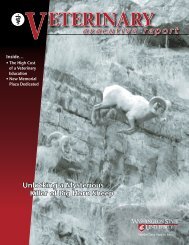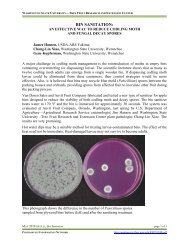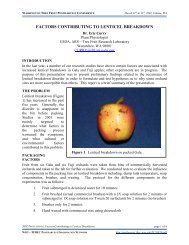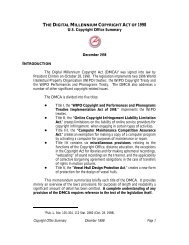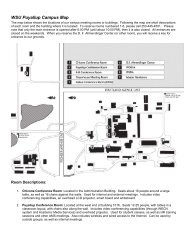Use of Ozone in Storage and Packing Facilities (PDF) - Postharvest ...
Use of Ozone in Storage and Packing Facilities (PDF) - Postharvest ...
Use of Ozone in Storage and Packing Facilities (PDF) - Postharvest ...
Create successful ePaper yourself
Turn your PDF publications into a flip-book with our unique Google optimized e-Paper software.
WASHINGTON TREE FRUIT POSTHARVEST CONFERENCEDecember 2 nd <strong>and</strong> 3 rd , 2003, Wenatchee, WAUSE OF OZONE IN STORAGE AND PACKING FACILITIESJoseph L. SmilanickResearch Plant Pathologist,San Joaqu<strong>in</strong> Agricultural Sciences Center,9611 South Riverbend Avenue, Parlier, California 93648Jsmilanick@fresno.ars.usda.gov<strong>Ozone</strong> is a highly reactive form <strong>of</strong> oxygen where three molecules are bonded together. Generatedelectrically on-site where needed, it has potent antimicrobial activity <strong>and</strong> other characteristics.Interest <strong>in</strong> ozone applications for agriculture <strong>and</strong> food process<strong>in</strong>g has <strong>in</strong>creased <strong>in</strong> recent years(EPRI Expert Panel 1997). In 2001, ozone was declared a GRAS (generally recognized as safe)substance by the FDA after a Food Additive Petition conta<strong>in</strong><strong>in</strong>g safety <strong>and</strong> efficacy data wassubmitted to them. Later, the USDA approved its use on meats <strong>and</strong> on certified organic foods. Inthe mid-1990s, ozone was approved for food process<strong>in</strong>g <strong>in</strong> Japan, France, <strong>and</strong> Australia. <strong>Ozone</strong>has a long history as a water dis<strong>in</strong>fectant, <strong>and</strong> it is <strong>in</strong> common use for this purpose <strong>in</strong> many parts<strong>of</strong> the world. Many aspects <strong>of</strong> ozone use have been reviewed: (1) water dis<strong>in</strong>fection applications(Nickols <strong>and</strong> Varas 1992; White 1999; Rice 1999); (2) food safety <strong>and</strong> sanitation (Graham et al.1997; Kim, Yousef <strong>and</strong> Dave 1999), (3) chemistry (Razumovski <strong>and</strong> Zaikov, 1984),(4) responses <strong>of</strong> horticultural products to ozone (Forney 2003); <strong>and</strong> (5) the practical aspects <strong>of</strong>the design <strong>and</strong> operation <strong>of</strong> ozonators (Rice <strong>and</strong> Netzer 1984). The purpose for this article is todescribe experiments where ozone applications <strong>in</strong> pack<strong>in</strong>ghouses have been evaluated.The units that express concentration <strong>of</strong> ozone <strong>in</strong> air <strong>and</strong> water are typically parts per million(ppm). In water, ppm is a unit <strong>of</strong> weight/volume (µg/mL), while <strong>in</strong> air, ppm is a unit <strong>of</strong>volume/volume (µL/L). A liter <strong>of</strong> water with a concentration <strong>of</strong> 1 ppm ozone has many ozonemolecules, while a liter <strong>of</strong> air with a concentration <strong>of</strong> 1 ppm ozone conta<strong>in</strong>s relatively few. Whencalculated, equal volumes <strong>of</strong> 1 ppm <strong>of</strong> ozone <strong>in</strong> water conta<strong>in</strong> 500,000 times as many moleculesas <strong>in</strong> 1 ppm ozone <strong>in</strong> air.<strong>Ozone</strong> <strong>in</strong> AirConceivable benefits <strong>of</strong> add<strong>in</strong>g ozone to air <strong>in</strong> pack<strong>in</strong>ghouses <strong>and</strong> storage rooms <strong>in</strong>clude control<strong>of</strong> postharvest diseases on fruit, retard<strong>in</strong>g the production <strong>of</strong> spores from decay<strong>in</strong>g fruit, sanitation<strong>of</strong> surfaces, <strong>and</strong> ethylene removal. Both benefit (J<strong>in</strong> et al. 1989; Hard<strong>in</strong>g 1968; Liew <strong>and</strong> Prange,1994; Palou et al. 2002; Palou et al. 2003; P<strong>in</strong>illa et al. 1996; Sarig et al. 1996; Skog <strong>and</strong> Chu2001) <strong>and</strong> lack <strong>of</strong> benefit (Hopk<strong>in</strong>s <strong>and</strong> Loucks 1949; Spald<strong>in</strong>g 1966; Spald<strong>in</strong>g 1968) <strong>of</strong> ozone <strong>in</strong>air use <strong>in</strong> fruit <strong>and</strong> vegetable storage rooms have been reported. Forney (2003) recently reviewedthis subject.Schomer <strong>and</strong> McColloch (1948) summarized the risks <strong>and</strong> benefits <strong>of</strong> air ozonation <strong>in</strong> applestorage. <strong>Ozone</strong> did not control decay <strong>of</strong> apples, <strong>and</strong> it did not reduce <strong>in</strong>fection <strong>of</strong> <strong>in</strong>oculatedwounds, although it did retard the rate <strong>of</strong> enlargement <strong>of</strong> the <strong>in</strong>fected areas. Spores <strong>of</strong>Penicillium expansum unprotected by fruit tissue or other organic matter were killed bycont<strong>in</strong>uous exposure to ozone. Colonies established on package surfaces, however, were veryresistant <strong>and</strong> were not killed by cont<strong>in</strong>uous exposure for 5 months to an atmosphere conta<strong>in</strong><strong>in</strong>g3.25 ppm ozone. Scald was not controlled by ozone, but its development was reduced. Fruit were<strong>in</strong>jured by a daily exposure to 3.25 ppm ozone. The exposure period that caused <strong>in</strong>jury <strong>and</strong> the2003 PROCEEDINGS, <strong>Use</strong> <strong>of</strong> <strong>Ozone</strong> <strong>in</strong> <strong>Storage</strong> <strong>and</strong> Pack<strong>in</strong>g <strong>Facilities</strong> page 1 <strong>of</strong> 10WSU—TFREC POSTHARVEST INFORMATION NETWORKhttp://postharvest.tfrec.wsu.edu/PC2003H.pdf
WASHINGTON TREE FRUIT POSTHARVEST CONFERENCEDecember 2 nd <strong>and</strong> 3 rd , 2003, Wenatchee, WAdegree <strong>of</strong> <strong>in</strong>jury varied with the variety. No fruit were <strong>in</strong>jured by daily exposure for five monthsto 1.95 ppm. The flavor <strong>of</strong> all varieties tested except Golden Delicious was impaired by3.25 ppm <strong>of</strong> ozone, but no impairment was caused by 1.95 ppm on any variety tested. The cuticle<strong>of</strong> some varieties became sticky <strong>and</strong> varnish-like <strong>in</strong> the presence <strong>of</strong> ozone. No differences <strong>in</strong> thephysiological properties between treated <strong>and</strong> untreated fruit were detected.This work is quite complete <strong>and</strong> agrees with that <strong>of</strong> other workers. An issue <strong>in</strong> many olderreports is that they did not use dry air <strong>in</strong> their ozone generators, so they may have producedozone <strong>and</strong> other oxidants such as hydrogen peroxide, nitrous oxide, <strong>and</strong> nitric acid (Peyrous1990) that may be responsible for some <strong>of</strong> the effects they observed. The effect <strong>of</strong> low ozoneconcentrations (0.3 to 1.0 ppm) on other fruit has been reported. Observations <strong>in</strong>clude a slightbut significant <strong>in</strong>hibition by ozone <strong>of</strong> the rate <strong>of</strong> decay <strong>of</strong> oranges <strong>and</strong> lemons by Penicilliumdigitatum <strong>and</strong> P. italicum (Palou et al. 2001), <strong>of</strong> strawberries by Botrytis c<strong>in</strong>erea (Nadas at al.2003), <strong>and</strong> peaches by Monil<strong>in</strong>ia fructicola (Palou et al. 2001). <strong>Ozone</strong> at these low rates retardedthe production <strong>of</strong> spores from <strong>in</strong>fected fruit or cultures (Hard<strong>in</strong>g 1968; Palou et al. 2001; Palou etal. 2003; Nadas et al. 2003). Spore production is retarded when the gas is present, <strong>and</strong> resumeswhen the fruit are removed from the atmosphere. B. c<strong>in</strong>erea spores prepared from coloniesgrown <strong>in</strong> ozonated air were as <strong>in</strong>fectious to strawberries as those from air (Nadas et al. 2003).Inhibition <strong>of</strong> spore production can be valuable because the population <strong>of</strong> spores with<strong>in</strong> thepack<strong>in</strong>ghouse that can cause additional cycles <strong>of</strong> <strong>in</strong>fection <strong>and</strong> decay are not produced. In somecitrus pack<strong>in</strong>ghouses today, a high proportion <strong>of</strong> the green mold spores present are resistant tothe fungicides available for use. Decay lesions caused by resistant fungi produce copious spores,<strong>in</strong> spite <strong>of</strong> the presence <strong>of</strong> ample fungicide residues, <strong>and</strong> exacerbate the build-up <strong>of</strong> resistantspores <strong>and</strong> decay losses. In these cases, ozone could retard the production <strong>of</strong> these spores whenno other method is available. Sporulation control with ozone has been repeatedly demonstratedwhen the citrus fruit are <strong>in</strong> cold storage at 50 °F or less (Palou et al. 2001).A fundamental issue is penetration by ozone <strong>in</strong>to fruit conta<strong>in</strong>ers. <strong>Ozone</strong> penetration <strong>in</strong>to mostconventional citrus packages is poor <strong>and</strong> adequate penetration occurs only packages with largevents or open tops (Hard<strong>in</strong>g 1968; Palou et al. 2003). Palou et al. (2003) showed <strong>in</strong> a roomconta<strong>in</strong><strong>in</strong>g 0.7 ppm ozone, penetration <strong>in</strong>to returnable plastic conta<strong>in</strong>ers with large vents wasgood. The ozone concentration <strong>in</strong>side them was 0.6 ppm, <strong>and</strong> good sporulation control wasevident. However, penetration <strong>in</strong>to oranges with plastic bags or fiberboard cartons was 0.1 ppmor less <strong>and</strong> sporulation was not controlled.Sanitation <strong>of</strong> equipment <strong>and</strong> fruit surfaces with ozone gas has been reported, but doses <strong>of</strong> ozonethat kill postharvest pathogenic fungi <strong>in</strong> a few hours or days are very high <strong>and</strong> to use themrequires very ozone-tolerant products, corrosion-resistant facilities that conta<strong>in</strong> the gas, <strong>and</strong>presumably other measures to scrub ozone from vented air <strong>and</strong> other safety measures. Weexposed spores on glass slides, then r<strong>in</strong>sed <strong>of</strong>f the spores on to agar media to determ<strong>in</strong>e theirgerm<strong>in</strong>ability. We used glass slides because we found spores exposed to ozone on agar mediatypically die at much lower doses than those on hard surfaces (Li <strong>and</strong> Wang 2003). To kill spores<strong>of</strong> the pathogens that cause green mold, blue mold, <strong>and</strong> sour rot (Penicillium digitatum,P. italicum, <strong>and</strong> Geotrichum citri-auranatii, respectively) <strong>in</strong> humid air (about 95% RH) at 5 °Cwith<strong>in</strong> one hour, we found about 200 ppm ozone was required. If the air was dry (35% RH), adose 5 to 10 times higher was required. The feasibility <strong>of</strong> us<strong>in</strong>g ozone gas to rapidly kill fungi onfresh fruit is limited because <strong>in</strong> a survey <strong>of</strong> more than 60 fresh products we found many were2003 PROCEEDINGS, <strong>Use</strong> <strong>of</strong> <strong>Ozone</strong> <strong>in</strong> <strong>Storage</strong> <strong>and</strong> Pack<strong>in</strong>g <strong>Facilities</strong> page 2 <strong>of</strong> 10WSU—TFREC POSTHARVEST INFORMATION NETWORKhttp://postharvest.tfrec.wsu.edu/PC2003H.pdf
WASHINGTON TREE FRUIT POSTHARVEST CONFERENCEDecember 2 nd <strong>and</strong> 3 rd , 2003, Wenatchee, WAat practical concentrations (200 µg/mL or less) did not control <strong>in</strong>fections with<strong>in</strong> <strong>in</strong>oculatedwounds on citrus (Eckert <strong>and</strong> Eaks 1989; Smilanick et al. 2002A) or pear (Spotts <strong>and</strong> Peters1980) fruit.Safety<strong>Ozone</strong> is toxic <strong>and</strong> workers must be protected from it. The federal exposure limit <strong>in</strong> workplacesfor ozone gas, a time-weighted average dur<strong>in</strong>g an eight-hour workday, is 0.1 ppm. Theconcentration that is “immediately dangerous to life <strong>and</strong> health” (IDHL) is 5 ppm. This is themaximum concentration for which there are approved respirators; higher rates than this aredangerous <strong>and</strong> require self-conta<strong>in</strong>ed breath<strong>in</strong>g equipment. To be <strong>in</strong> compliance with state <strong>and</strong>federal safety codes, the capability to determ<strong>in</strong>e ozone concentrations <strong>in</strong> air on-site is usuallyrequired.2003 PROCEEDINGS, <strong>Use</strong> <strong>of</strong> <strong>Ozone</strong> <strong>in</strong> <strong>Storage</strong> <strong>and</strong> Pack<strong>in</strong>g <strong>Facilities</strong> page 5 <strong>of</strong> 10WSU—TFREC POSTHARVEST INFORMATION NETWORKhttp://postharvest.tfrec.wsu.edu/PC2003H.pdf
WASHINGTON TREE FRUIT POSTHARVEST CONFERENCEDecember 2 nd <strong>and</strong> 3 rd , 2003, Wenatchee, WATable 1. Comparison <strong>of</strong> various aspects <strong>of</strong> hypochlorite <strong>and</strong> ozone use <strong>in</strong> water.Attribute Hypochlorite <strong>Ozone</strong>Microbial potencyKills plant pathogens <strong>and</strong> microbial saprophytes effectively.Some human-pathogenic, spore-form<strong>in</strong>g protozoa resistant.Maximum allowable rates under regulatory control.CostInfluence <strong>of</strong> pHDis<strong>in</strong>fection by-productsWorker safety issuesPersistence <strong>in</strong> water<strong>Use</strong> rates<strong>Use</strong> <strong>in</strong> warm waterInfluence on product qualityImpact on water qualityCorrosivenessChemical cost low. Repeated delivery required, sometimespH <strong>and</strong> concentration controller systems needed, m<strong>in</strong>orma<strong>in</strong>tenance <strong>and</strong> energy costs, chlor<strong>in</strong>e storage issues. Needwater <strong>of</strong> at least moderate quality.Efficacy dim<strong>in</strong>ishes as pH <strong>in</strong>creases, above pH 8, pHadjustment may be needed. Chlor<strong>in</strong>e gas released at very lowpH (4 or less.)Some regulatory concern, tri-halo compounds, particularlychlor<strong>of</strong>orm, <strong>of</strong> some human safety concern.Chloram<strong>in</strong>es can form <strong>and</strong> produce an irritat<strong>in</strong>g vapor.Chlor<strong>in</strong>e gas systems require on-site safety measures OSHA(TWA) limit for chlor<strong>in</strong>e gas: 1 µg/mL.Persists hours <strong>in</strong> clean water, persistence reduced to m<strong>in</strong>utes<strong>in</strong> dirty water.Limited by regulation to 25 to 600 µg/mL, depend<strong>in</strong>g onapplication.Increases potency, some <strong>in</strong>crease <strong>in</strong> vapors.Little risk <strong>of</strong> <strong>in</strong>jury at recommended rates <strong>of</strong> 200 µg/mL orless.M<strong>in</strong>or negative impact: water salt concentration <strong>in</strong>creasessomewhat, may <strong>in</strong>terfere with fermentation used to reduceBiological Oxygen Dem<strong>and</strong>, some pesticides <strong>in</strong>activated,discharge water dechlor<strong>in</strong>ation may be required.High, particularly iron <strong>and</strong> mild steel damaged.Kills plant pathogens <strong>and</strong> microbial saprophytes effectively,<strong>in</strong>clud<strong>in</strong>g spore-form<strong>in</strong>g protozoa. Maximum rate limited by ozonesolubility, difficult to exceed about 10 µg/mL.Variable: no chemical cost, but high <strong>in</strong>itial capital cost for generator,usually needs filtration system if water re-used Generators arecomplex, modest ma<strong>in</strong>tenance <strong>and</strong> energy costs. Must have highquality, clean water with low oxidation/reduction potential.Potency not <strong>in</strong>fluenced very much by pH, but ozone decomposition<strong>in</strong>creases rapidly above pH 8.Less regulatory concern, small <strong>in</strong>crease <strong>in</strong> aldehydes, ketones,alcohols, <strong>and</strong> carboxylic acids created from organics, bromate canform from brom<strong>in</strong>e.Off-gas ozone from solutions an irritant <strong>and</strong> must be managed.MnO 2 ozone destruction efficient <strong>and</strong> long-lived. OSHA (TWA)limit for ozone gas: 0.1 ppm (µL/L).Persists m<strong>in</strong>utes, clean water, persistence reduced to seconds <strong>in</strong> dirtywater.Not limited by regulation, but Henry's law limits theoreticalmaximum ozone <strong>in</strong> water to about 30 ppm (µg/L at 20 °C (68 °F).Most ozone systems produce 5 µg/mL or less.Not practical, rapidly accelerates ozone decomposition, <strong>in</strong>creases<strong>of</strong>f-gass<strong>in</strong>g, decreases ozone solubility.In brief water <strong>and</strong> low concentration gas applications, risk <strong>of</strong> <strong>in</strong>juryto citrus appears low, but needs more evaluation.Mostly positive impact: does not <strong>in</strong>crease salt <strong>in</strong> water, manypesticides decomposed, Biological/Chemical Oxygen Dem<strong>and</strong> maybe reduced, flocculation <strong>and</strong> biodegradability <strong>of</strong> many organiccompounds enhanced, precipitates iron, removes color, odors.Higher, particularly rubber, some plastics, yellow metals, alum<strong>in</strong>um,iron, z<strong>in</strong>c, <strong>and</strong> mild steel corroded.2003 PROCEEDINGS, Organic Certification <strong>in</strong> the United States <strong>and</strong> Europe page 6 <strong>of</strong> 10WSU—TFREC POSTHARVEST INFORMATION NETWORKhttp://postharvest.tfrec.wsu.edu/PC2003E.pdf
WASHINGTON TREE FRUIT POSTHARVEST CONFERENCEDecember 2 nd <strong>and</strong> 3 rd , 2003, Wenatchee, WAGerm<strong>in</strong>ation (%)1007550Geotrichum citri-aurantiiPenicillium digitatumPenicillium italicumRhizopus stoloniferBotrytis c<strong>in</strong>ereaPenicillium expansumMonil<strong>in</strong>ia fructicola2500 0.5 1 1.5 2 2.5 3Contact time (m<strong>in</strong>)Figure 1. Germ<strong>in</strong>ation <strong>of</strong> spores <strong>of</strong> various postharvest pathogenic fungi after exposure to1.5 ppm (µg/mL) ozone <strong>in</strong> water at 16.5 °C (62 °F) <strong>and</strong> pH 6.4.2003 PROCEEDINGS, Organic Certification <strong>in</strong> the United States <strong>and</strong> Europe page 7 <strong>of</strong> 10WSU—TFREC POSTHARVEST INFORMATION NETWORKhttp://postharvest.tfrec.wsu.edu/PC2003E.pdf
WASHINGTON TREE FRUIT POSTHARVEST CONFERENCEDecember 2 nd <strong>and</strong> 3 rd , 2003, Wenatchee, WALiterature CitedAchen, M. <strong>and</strong> Yousef, A. E. 2001. Efficacy <strong>of</strong> ozone aga<strong>in</strong>st Escherichia coli 0157: H7 onapples. J. Food Sci. 66:1380-1384.Dickson, R. G., Law, S. E., Kays, S. J., Eiteman, M. A. 1992. Abatement <strong>of</strong> ethylene by ozonetreatment <strong>in</strong> controlled atmosphere storage <strong>of</strong> fruits <strong>and</strong> vegetables. Proc. 1992International W<strong>in</strong>ter Meet<strong>in</strong>g, Am. Soc. Agric. Eng. 1-9.Eckert, J. W., <strong>and</strong> Eaks, I. L. 1989. <strong>Postharvest</strong> disorders <strong>and</strong> diseases <strong>of</strong> citrus fruits. Pages 179-260 <strong>in</strong>: The Citrus Industry. Vol. 4. W. Reuther, E. C. Calavan, <strong>and</strong> G. E. Carman, eds.University <strong>of</strong> California Press, Berkeley.EPRI (Electric Power Research Institute) “expert panel” U.S. Food <strong>and</strong> Drug Adm<strong>in</strong>istration,1997. Substances generally recognized as safe, proposed rule. Federal Register 62(74):18937-18964 (April 19, 1997).Forney, C. F. 2003. <strong>Postharvest</strong> response <strong>of</strong> horticultural products to ozone. pp. 13-53 <strong>in</strong>:<strong>Postharvest</strong> oxidative stress <strong>in</strong> horticultural crops. Food Products Press. B<strong>in</strong>ghamton,Engl<strong>and</strong>.Graham, D.M., Pariza, M., Glaze, W. H., Newell, G. W., Erdman, J. W., Borzelleca, J. F. 1997.<strong>Use</strong> <strong>of</strong> ozone for food preservation. Food Technol. 51(6):72-76.Hard<strong>in</strong>g, P. R. 1968. Effect <strong>of</strong> ozone on Penicillium mold decay <strong>and</strong> sporulation. Plant Dis. Rept.52:245-247.Hopk<strong>in</strong>s, E. F. <strong>and</strong> Loucks. K. W. 1949. Has ozone any value <strong>in</strong> the treatment <strong>of</strong> citrus fruit fordecay? Citrus Industry 30:5-7, 22.Hwang, E.-S., Cash, J. N., <strong>and</strong> Zabik, M. J. 2001. <strong>Postharvest</strong> treatments for the reduction <strong>of</strong>mancozeb <strong>in</strong> fresh apples. J. Agric. Food Chem. 49:3127-3132J<strong>in</strong>, L., Xiaoyu, W., Hongl<strong>in</strong>, Y., Zonggan, Y., Jiaxun, W., <strong>and</strong> Yaguang, L. 1989. Influence <strong>of</strong>discharge products on post-harvest physiology <strong>of</strong> fruit. Proc. 6th International Symp.High Voltage Eng., New Orleans, LA, August 28 to September 1, 1989; 1-4.Kim, J.-G., Yousef, A. E., <strong>and</strong> Dave, S. 1999. Application <strong>of</strong> ozone for enhanc<strong>in</strong>g themicrobiological safety <strong>and</strong> quality <strong>of</strong> foods: a review. J. Food Protect. 62:1071-1087.Li., C. -S. <strong>and</strong> Wang, Y.- C. 2003. Surface germicidal effects <strong>of</strong> ozone for microorganisms.AIHA J. 64:533-537.Liew, C. L. <strong>and</strong> Prange, R. K. 1994. Effect <strong>of</strong> <strong>Ozone</strong> <strong>and</strong> <strong>Storage</strong> Temperature on <strong>Postharvest</strong>Diseases <strong>and</strong> Physiology <strong>of</strong> Carrots (Daucus carota L.). J. Amer. Soc. Hortic. Sci.:119:563-567.McKenzie, K. S., Sarr, A. B. Mayura, K., Bailey, R. H., Miller, D. R., Rogers, T. D., Norred, W.P., Voss, K. A., Plattner, R. D., Kubena, L. F., <strong>and</strong> Phillips, T. D. 1997. Oxidativedegradation <strong>and</strong> detoxification <strong>of</strong> mycotox<strong>in</strong>s us<strong>in</strong>g a novel source <strong>of</strong> ozone. Food ChemToxicol. 35:807-820.Nadas, A., Olmo, M., <strong>and</strong> Garcia, J. M. 2003. Growth <strong>of</strong> Botrytis c<strong>in</strong>erea <strong>and</strong> strawberry quality<strong>in</strong> ozone-enriched atmospheres. J. Food Sci. 68:1798-1802.2003 PROCEEDINGS, Organic Certification <strong>in</strong> the United States <strong>and</strong> Europe page 8 <strong>of</strong> 10WSU—TFREC POSTHARVEST INFORMATION NETWORKhttp://postharvest.tfrec.wsu.edu/PC2003E.pdf
WASHINGTON TREE FRUIT POSTHARVEST CONFERENCEDecember 2 nd <strong>and</strong> 3 rd , 2003, Wenatchee, WANickols, D. <strong>and</strong> Varas, A. J. 1992. Ozonation. Pp. 197-258 <strong>in</strong>: Dis<strong>in</strong>fection alternatives for safedr<strong>in</strong>k<strong>in</strong>g water. Bryant, E.A., Fulton, G. P., <strong>and</strong> Budd, G. C. Van Nostr<strong>and</strong> Re<strong>in</strong>hold,New York.Ong, K. C., Cash, I N., Zabik, M. J., Siddiq M., <strong>and</strong> Jones A. L.1996. Chlor<strong>in</strong>e <strong>and</strong> ozone washesfor pesticide removal from apples <strong>and</strong> processed apple sauce. Food Chem.55:153-160.Palou, L., Smilanick, J. L., Crisosto, C. H., <strong>and</strong> Mansour, M. 2001. Effect <strong>of</strong> gaseous ozone onthe development <strong>of</strong> green <strong>and</strong> blue molds on cold stored citrus fruit. Plant Disease85:632-638.Palou, L., Crisosto, C. H., Smilanick, J. L., Adaskaveg, J. E., <strong>and</strong> Z<strong>of</strong>foli, J. P. 2002. Effects <strong>of</strong>cont<strong>in</strong>uous 0.3 ppm ozone exposure on decay development <strong>and</strong> physiological responses<strong>of</strong> peaches <strong>and</strong> table grapes <strong>in</strong> cold storage. <strong>Postharvest</strong> Biol. Technol. 24:39-48.Palou, L., Smilanick, J. L., Crisosto, C. H., Mansour, M., <strong>and</strong> Plaza, P. 2003. <strong>Ozone</strong> gaspenetration <strong>and</strong> control <strong>of</strong> the sporulation <strong>of</strong> Penicillium digitatum <strong>and</strong> Penicilliumitalicum with<strong>in</strong> commercial packages <strong>of</strong> oranges dur<strong>in</strong>g cold storage. Crop Prot. 22:1131-1134.Peyrous, R. 1990. The effect <strong>of</strong> relative humidity on ozone production by corna discharge <strong>in</strong>oxygen or air – a numerical simulation – part II: air. <strong>Ozone</strong> Sci. Eng. 12:41-64.P<strong>in</strong>illa, B. L., Alvarez, M., <strong>and</strong> Godoy, P. 1996. Effect <strong>of</strong> ionization <strong>in</strong> the control <strong>of</strong> gray moldon kiwi fruit. Rev. Fruticola 17:61-64.Razumovski, S. D. <strong>and</strong> Zaikov, G. E., 1984. <strong>Ozone</strong> <strong>and</strong> its reactions with organic compounds.Elsevier, New York.Rice, R. G. 1999. <strong>Ozone</strong> <strong>in</strong> the United States -- State-Of-The-Art. <strong>Ozone</strong> Sci. Eng. 21:99-118.Rice, R. G., <strong>and</strong> Netzer, A. 1984. H<strong>and</strong>book <strong>of</strong> ozone technology <strong>and</strong> applications. Vol. 2.<strong>Ozone</strong> for dr<strong>in</strong>k<strong>in</strong>g water treatment. Butterworth, Stoneham, MA.Sarig. P., T. Zahvi, T., Zutkhi, Y., Yannai, S., Lisker, N., <strong>and</strong> Ben-Arie, R. 1996. <strong>Ozone</strong> forcontrol <strong>of</strong> post-harvest decay <strong>of</strong> table grapes caused by Rhizopus stolonifer. Physiol.Molecular Plant Pathol. 48:403-415.Schomer, H. A., <strong>and</strong> McColloch, L. P. 1948. <strong>Ozone</strong> <strong>in</strong> relation to storage <strong>of</strong> apples. USDACircular #765. 24 pps.Skog, L. J. <strong>and</strong> Chu, C. L. 2001. Effect <strong>of</strong> ozone on qualities <strong>of</strong> fruits <strong>and</strong> vegetables <strong>in</strong> coldstorage. Can. J. Plant Sci. 81: 773-778.Smilanick, J. L., J. Aiyabei, M. Mlikota Gabler, J. Doctor, <strong>and</strong> D. Sorenson. 2002A.Quantification <strong>of</strong> the toxicity <strong>of</strong> aqueous chlor<strong>in</strong>e to spores <strong>of</strong> Penicillium digitatum <strong>and</strong>Geotrichum citri-aurantii. Plant Dis. 86:509-514.Smilanick, J. L., Margosan, D. M., <strong>and</strong> Mlikota Gabler, F. 2002B. Impact <strong>of</strong> ozonated water onthe quality <strong>and</strong> shelf-life <strong>of</strong> fresh citrus fruit, stone fruit, <strong>and</strong> table grapes. zone Sci. Eng.24:343-356.2003 PROCEEDINGS, Organic Certification <strong>in</strong> the United States <strong>and</strong> Europe page 9 <strong>of</strong> 10WSU—TFREC POSTHARVEST INFORMATION NETWORKhttp://postharvest.tfrec.wsu.edu/PC2003E.pdf
WASHINGTON TREE FRUIT POSTHARVEST CONFERENCEDecember 2 nd <strong>and</strong> 3 rd , 2003, Wenatchee, WASpald<strong>in</strong>g, D. H. 1966. Appearance <strong>and</strong> decay <strong>of</strong> strawberries, peaches, <strong>and</strong> lettuce treated withozone. Agricultural Research Service, USDA Market<strong>in</strong>g Research Report No. 756.Spald<strong>in</strong>g, D. H. 1968. Effects <strong>of</strong> ozone atmospheres on spoilage <strong>of</strong> fruits <strong>and</strong> vegetables afterharvest. Agricultural Research Service USDA Market<strong>in</strong>g Research Report No. 801.Spotts, R. A., <strong>and</strong> Peters, B. B. 1980. Chlor<strong>in</strong>e <strong>and</strong> chlor<strong>in</strong>e dioxide for control <strong>of</strong> d'Anjou peardecay. Plant Dis. 64:1095-1097.Spotts, R. A., <strong>and</strong> Cervantes, L. A. 1992. Effect <strong>of</strong> ozonated water on postharvest pathogens <strong>of</strong>pear <strong>in</strong> laboratory <strong>and</strong> pack<strong>in</strong>ghouse tests. Plant Dis. 76:256-259.Strasser, J. 1998. <strong>Ozone</strong> applications <strong>in</strong> apple process<strong>in</strong>g. The challenge: reduce flume waterusage <strong>and</strong> keep Tastee Apples tasty. EPRI Techapplication 2 pp.Tukey, B. 1993. Overview <strong>of</strong> ozone use at Snokist growers. Wash. State University Tree Fruit<strong>Postharvest</strong> Journal 4:14-15.White, G. C. 1999. <strong>Ozone</strong>. Pp. 1203-1261 <strong>in</strong>: H<strong>and</strong>book <strong>of</strong> chlor<strong>in</strong>ation <strong>and</strong> alternativedis<strong>in</strong>fectants. Fourth Edition. Van Nostr<strong>and</strong> Re<strong>in</strong>hold, New York.Wild, B. L., McGlasson,W. B., <strong>and</strong> Lee, T. H. 1976. Effect <strong>of</strong> reduced ethylene levels <strong>in</strong> storageatmospheres on lemon keep<strong>in</strong>g quality. HortScience 11:114-1152003 PROCEEDINGS, Organic Certification <strong>in</strong> the United States <strong>and</strong> Europe page 10 <strong>of</strong> 10WSU—TFREC POSTHARVEST INFORMATION NETWORKhttp://postharvest.tfrec.wsu.edu/PC2003E.pdf



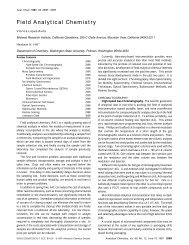
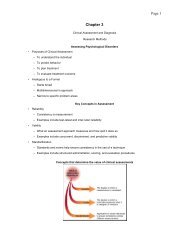


![Graduate School Policies & Procedures Manual 2011 - 2012 [PDF]](https://img.yumpu.com/50747405/1/190x245/graduate-school-policies-procedures-manual-2011-2012-pdf.jpg?quality=85)
